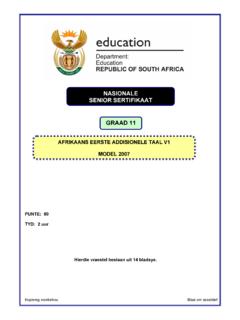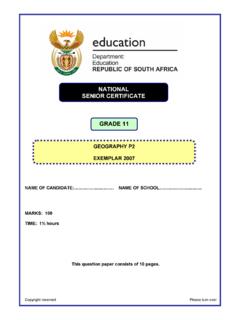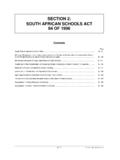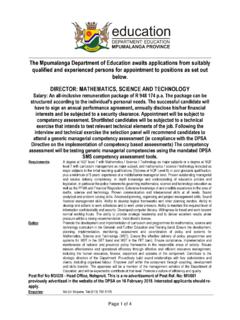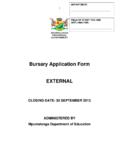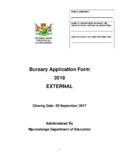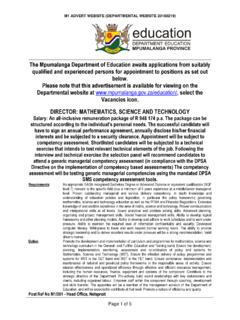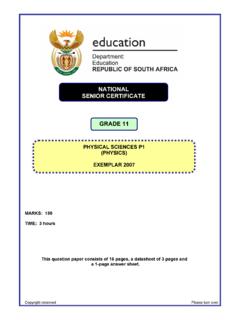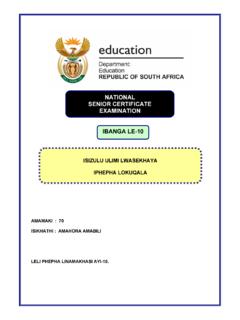Transcription of NATIONAL SENIOR CERTIFICATE GRADE 10 - Mpumalanga
1 Copyright reserved Please turn over MARKS: 300 TIME: 3 hours This question paper consits of 23 pages and an answer book. ACCOUNTING NOVEMBER 2006 NATIONAL SENIOR CERTIFICATEGRADE 10 Accounting DoE/November 2006 NSC Copyright reserved Please turn over 2 INSTRUCTIONS AND INFORMATION 1. 2. 3. 4. 5. 6. 7. 8. You are provided with a question paper and an ANSWER BOOK. This question paper comprises FOUR compulsory questions. The compulsory questions are QUESTIONS 1, 2, 3 and 4.
2 Answer ALL these questions. You must also answer ONE other question; EITHER QUESTION 5 OR QUESTION 6. Use the formats provided in order to reflect your answers. Workings must be shown in order to achieve part-marks. You must attempt to comply with the suggested time allocations. Non-programmable calculators may be used. You may use pencil or blue/black ink to answer the questions. Accounting DoE/November 2006 NSC Copyright reserved Please turn over 3 QUESTION 1: 40 marks; 25 minutes The topic of the question is: The learning outcomes covered are: Cost concepts and VAT LO1 Financial information AS7 VAT LO2 Managerial accounting AS2 Identify basic cost concepts LO3 Managing resources AS6 Knowledge of internal control QUESTION 2: 50 marks.
3 25 minutes The topic of the question is: The learning outcomes covered are: Bookkeeping entries and accounting equation LO1 Financial information AS2 Use of source documents & ledger AS3 Accounting equation LO3 Managing resources AS4 Ledger for perpetual inventory system QUESTION 3: 80 marks; 50 minutes The topic of the question is: The learning outcomes covered are: Salaries, budgets and ethics LO2 Managerial accounting AS1 Financial and managerial accounting AS3 Budget concepts LO3 Managing resources AS2 Salaries and wages AS5 Ethics QUESTION 4: 70 marks.
4 45 minutes The topic of the question is: The learning outcomes covered are: Financial statements and concepts LO1 Financial information AS1 Accounting concepts AS5 Financial statements of sole traders CHOOSE EITHER QUESTION 5 OR QUESTION 6. QUESTION 5: 60 marks; 35 minutes The topic of the question is: The learning outcomes covered are: Interpreting financial statements LO1 Financial information AS5 Financial statements of sole traders LO3 Managing resources AS6 Internal control QUESTION 6: 60 marks.
5 35 minutes The topic of the question is: The learning outcomes covered are: Debtors and creditors LO1 Financial information AS2 Use of source documents & ledger LO3 Managing resources AS6 Internal control Accounting DoE/November 2006 NSC Copyright reserved Please turn over 4 QUESTION 1: COST CONCEPTS AND VAT (40 marks; 25 minutes) Jossie Jordan inherits R8 000 from her grandmother which she decides to use to start her own business. She receives a knitting machine as a birthday gift from her mother and decides to start a rug-making business.
6 During her first month of operation, September 2006, she bought wool and yarn to the value of R2 250 from a local supplier. She approaches a friend of hers, Samantha, to assist her in producing the rugs. She will pay Samantha R1 200 per month. She hires a garage from a next-door neighbour for R250 per month to produce and store her products and materials. The neighbour charges her an amount of R300 per month for electricity. She purchases plastic containers in bulk at a price of R375 for 100 containers to package each rug.
7 She purchases an initial number of 200 plastic containers. During her first month she produced 150 rugs, which she and her assistant sold to friends, family and the local store at a price of R65. She used all the wool and yarn but she has 50 plastic containers left over. They managed to sell all 150 rugs. REQUIRED: Explain why rent is regarded as a fixed cost and the plastic containers as a variable cost. Using Jossie's costs listed above, give TWO examples of fixed costs and TWO examples of variable costs, other than those mentioned in QUESTION Calculate the total cost of producing 150 rugs including the cost of the containers.
8 Calculate what it costs Jossie to produce ONE rug, including the cost of the container. (4) (4) (8) (4) Accounting DoE/November 2006 NSC Copyright reserved Please turn over 5 Because of the overwhelmingly good response to her product, Jossie and her assistant have decided to apply for a stall at the Port Elizabeth beachfront in October 2006. This stall costs Jossie R500 per month. She also advertises in the local community newsletter at a cost of R50 per week. She estimates that she can double her production.
9 Jossie has hired another assistant, Peter, to manage the stall while she and Samantha manufacture the rugs. She pays Peter R1 000 per month. After the first month Jossie does a physical count of the rugs at the stall. Jossie had given Peter 225 rugs during the course of the month. She received R11 830 from Peter for the rugs sold. The physical count shows that there are 32 rugs on hand. REQUIRED: Jossie is convinced that Peter has not accounted for all the rugs entrusted to him.
10 Calculate the number of rugs which appear to be missing. In your opinion, do the costs of the stall make it worthwhile for Jossie to continue selling her rugs at the beachfront? Explain briefly. What advice would you offer her? (6) (5) VAT Jossie realises that she has paid VAT on certain items that she has purchased. She also finds out that any business of which the turnover is more than R20 000 per annum and less than R300 000 per annum, may register as a VAT vendor, however, it is not compulsory.
